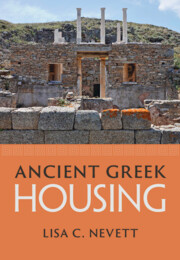Book contents
- Ancient Greek Housing
- Ancient Greek Housing
- Copyright page
- Contents
- Figures
- Maps
- Preface
- Acknowledgements
- Chronology
- 1 Introducing Ancient Greek Housing
- 2 Greek Domestic Architecture ca. 950–500 BCE
- 3 Classical Athens and Attica
- 4 Housing in Mainland Greece during the Classical Period
- 5 Housing Greek Households in the Eastern, Western and Southern Mediterranean and Northern Black Sea Littoral
- 6 Housing, Power and Wealth in Greek Communities during the Late Classical and Early Hellenistic Periods
- 7 Greek Housing into the Hellenistic Period
- Epilogue: The Single-Entrance, Courtyard House and Beyond
- Glossary
- Selection of Ancient Texts in Translation
- Bibliographic Essay
- References
- Index
3 - Classical Athens and Attica
The Anatomy of Housing in a City and Its Territory
Published online by Cambridge University Press: 28 April 2023
- Ancient Greek Housing
- Ancient Greek Housing
- Copyright page
- Contents
- Figures
- Maps
- Preface
- Acknowledgements
- Chronology
- 1 Introducing Ancient Greek Housing
- 2 Greek Domestic Architecture ca. 950–500 BCE
- 3 Classical Athens and Attica
- 4 Housing in Mainland Greece during the Classical Period
- 5 Housing Greek Households in the Eastern, Western and Southern Mediterranean and Northern Black Sea Littoral
- 6 Housing, Power and Wealth in Greek Communities during the Late Classical and Early Hellenistic Periods
- 7 Greek Housing into the Hellenistic Period
- Epilogue: The Single-Entrance, Courtyard House and Beyond
- Glossary
- Selection of Ancient Texts in Translation
- Bibliographic Essay
- References
- Index
Summary
Chapter 3 investigates the physical characteristics and social significance of Classical houses from Athens and Attica, comparing structures from the city, outlying villages or deme centres, and rural farms. Houses with four to five rooms or more share some characteristic elements in their basic layout: a single entrance designed to screen the interior from the street; an open courtyard; a portico adjacent to that courtyard; and rooms opening individually from the central court-portico area. These point to a distinctive form of dwelling, the ‘single-entrance, courtyard house’. Underlying this form were social expectations which included: restricting and/or monitoring movement in and out of the house; separation of male visitors from the remainder of the household; and potential for the surveillance of individuals moving around the interior of the house. Together, these elements suggest a desire to regulate contact between members of the household and outsiders. This corresponds with Classical Athenian authors, who imply that the movement and social contacts of citizens’ wives were limited.
Keywords
- Type
- Chapter
- Information
- Ancient Greek Housing , pp. 66 - 105Publisher: Cambridge University PressPrint publication year: 2023

